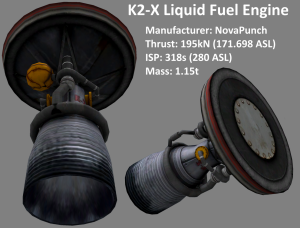 After months of competition between C7, Bluedog Design Bureau, Armstrong Siddeley & Royce Engineering, Archtagon Aerospace and more comprising a total of 12 designs, the Ascension program has awarded its1.25m lifter engine contract to NovaPunch and its K2-X!
After months of competition between C7, Bluedog Design Bureau, Armstrong Siddeley & Royce Engineering, Archtagon Aerospace and more comprising a total of 12 designs, the Ascension program has awarded its1.25m lifter engine contract to NovaPunch and its K2-X!
 Construction of the first prototype is being prepared to begin later this month for delivery towards the end of February, during which time a test stand will be erected out on the lawn of the R&D campus to which we can bolt down the engine and feed it propellants to see how it runs under controlled conditions. We’ll be performing several static fire tests to ensure operational capability before signing off on the final product to be installed at the bottom of the Ascension Mk1 for a launch in late March/early April, which we’ll have more details on next month as well.
Construction of the first prototype is being prepared to begin later this month for delivery towards the end of February, during which time a test stand will be erected out on the lawn of the R&D campus to which we can bolt down the engine and feed it propellants to see how it runs under controlled conditions. We’ll be performing several static fire tests to ensure operational capability before signing off on the final product to be installed at the bottom of the Ascension Mk1 for a launch in late March/early April, which we’ll have more details on next month as well.
Although in early planning last year we had hoped to stick a probe atop the Ascension Mk1 straightaway and head for orbit it has turned out that won’t be happening due to the fact that we haven’t been able to design a feasible probe that would last long enough on orbit to carry out a useful mission. Our current battery technology remains too inefficient to not add an unreasonable amount of mass to the payload for missions lasting longer than 20-30 minutes. Even in a circular 75km orbit it takes 31 minutes to come around once, and in order to maintain comms throughout the ascent and insertion we would have to launch inclined to pass over Sheltered Rock and Ockr, so our comm passes beneath the probe’s orbit when the probe is also overhead would be reduced. We also expect to end up in a much more eccentric orbit rather than a circular one which would make the orbital period even longer. Based on the average 0.13/s EC usage (130 Watts) of the last Mk5 mission we’re looking at around 12kg per 30 minutes of mission time, which not only adds up quick in mass but also in the overall size of the probe that has to carry all these batteries, and yes we did look at inline options. We’re going to find no help from kerbolar power either, R&D has only just begun to explore the materials required and is at least 1-2 years away from a part we could use on a mission, although we have granted them additional funding.
The best short-term solution we have available is Kuudite, which we covered when discussing how we would power the Extremis missions. The technology definitely needs to be tested thoroughly before being deployed on a multi-orbit mission but there’s the added danger of it being highly radioactive that requires a good deal of care in its use. Kuudite is also very dense and requires heavy shielding on top of that to permit safe handling by the VAB crews. Still, for a 143kg RTG (83kg of Kuudite, 60kg of shielding/re-entry encasement) that can put out 150 watts of power, its 9.2 year half-life will permit us to operate the probe for nearly 2 years before power levels drop below 130 watts! Although Kuudite is plentiful in the caverns discovered at Sheltered Rock mining it is very expensive and so processing enough material for the RTG means the cost per watt is much greater than batteries and re-usability is an important factor – we don’t plan to leave our initial orbital vehicles up in space.
While Kuudite solves our energy problems it introduces two major issues – probe balance and recovery. For the first, the problem facing engineers is how to mount the RTG so that the cold gas thrusters placed around the vehicle are able to control the attitude of the vessel without introducing torque that would require additional propellant to counter. If you want your probe to roll, you don’t also want it to pitch or yaw because that is extra movement that needs to be nulled out, and if nulling out that movement introduces more torque in another direction now you’re using propellant constantly just to maintain a given orientation and there won’t be enough for one orbit if it’s constantly being used. Center-mounting would of course be ideal, but not always feasible in the overall design.
For recovery, the obvious issue here is that failing to land safely could seriously irradiate a small portion of Kerbin’s surface if the RTG casing were to be cracked on impact. Part of the design for the RTG is to ensure it would survive re-entry in the event of a break-up of the vessel upon return but its ability to survive that scenario and impact with the ground/water is entirely theoretical. Any mishap during the ascent could also lead to unwanted radiation release into the environment. This is the primary reason the initial Ascension flights will not carry a functional orbital probe so it can be determined the lifter is able to reach orbit safely. The final flight before Kerbin I is launched will consist of a mockup which will be deliberately crashed on re-entry to see how the RTG casing handles it. Having to pass over Sheltered Rock and Ockr for persistent comms also keeps the rocket largely away from water, which would spread contamination much more seriously than if the RTG cracked on land.
So assuming the K2-X engine testing goes well we are looking to begin flying Ascension Mk1 lifters sometime in March/April with a series of flights to test ascent and near-orbital insertion. By July or August we hope to send up the Kerbin I mockup and follow it by the actual Kerbin I for our first orbital mission. We’ll have more information on all of these events as they draw closer.







